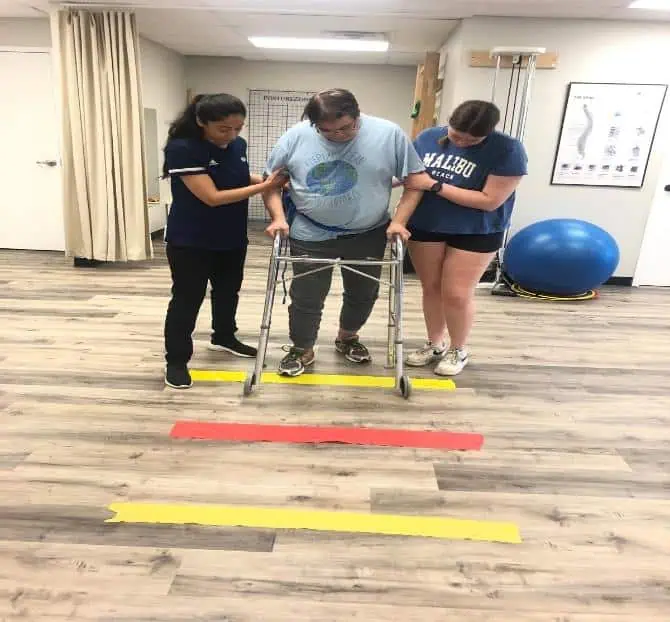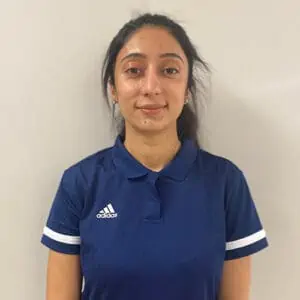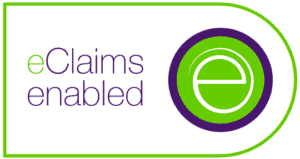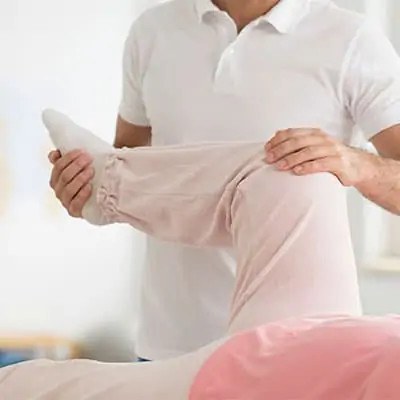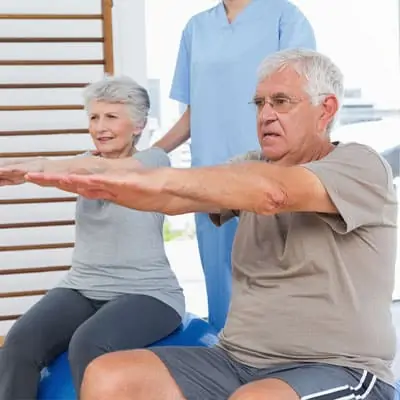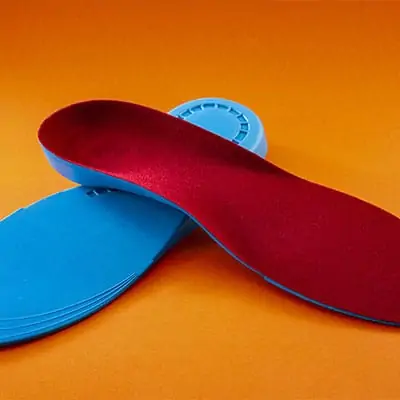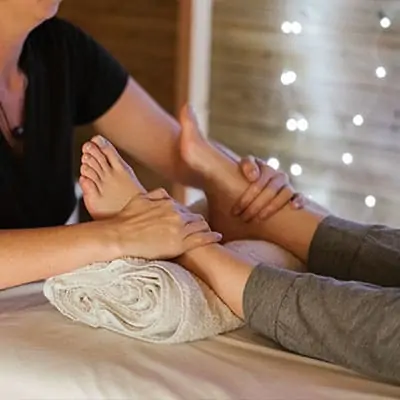A combined approach of physical therapy and pharmacological intervention plays a key role in the management of patients with PD. Early intervention is critical in preventing the devastating musculoskeletal impairments that patients are so prone to develop4. Physiotherapy treatment for those suffering from Parkinson’s includes motor learning strategies, relaxation exercises, resistance training, flexibility training, functional training, balance training, gait training, aerobic exercises, pulmonary rehabilitation, spinal orthotics, speech therapy, group/home exercises etc.
Enhancing Motor Learning through Physiotherapy
Here, we will focus on enhancing motor learning, as research shows that Physiotherapy and motor training are some of the most promising current options for improving Postural Instability and Gait disability1. In the early and middle stages of the disease, patients can improve their performance through practice and by using additional sensory information4. This is information received outside of other visual & auditory cues.
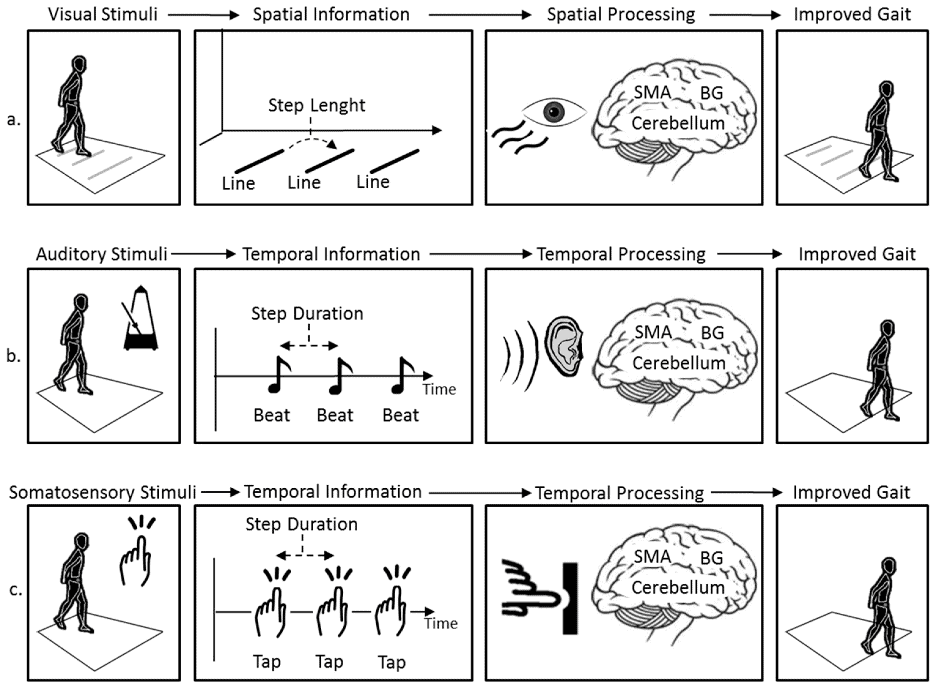
(A Technological Review of Wearable Cueing Devices Addressing Freezing of Gait in Parkinson’s Disease3)
Utilizing Visual and Auditory Cues in Motor Learning
External cues, such as verbal instruction along with some visual aids, have been shown to be effective in triggering sequential movements and improving movement characteristics in individuals with mild to moderate Parkinsons. External cues appear to facilitate movement by utilizing different brain areas for example, the premotor cortex is active in the generation of movement in response to visual and auditory stimuli4.
Visual Cueing Techniques
Visual cues include stationary floor markings for e.g. brightly colored lines on the floor placed perpendicular to the gait path, spaced about one step length apart and dynamic transportable cues e.g. laser light signals. The Laser light projects a line onto the floor and can be mounted on a cane, walker or chest harness. Visual cues have been shown to improve step/stride length and speed while walking. Freezing episodes are also reduced4.
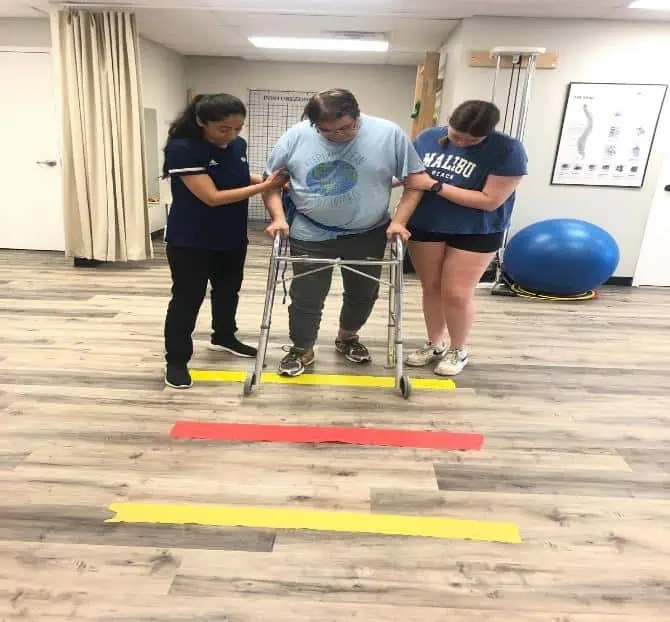
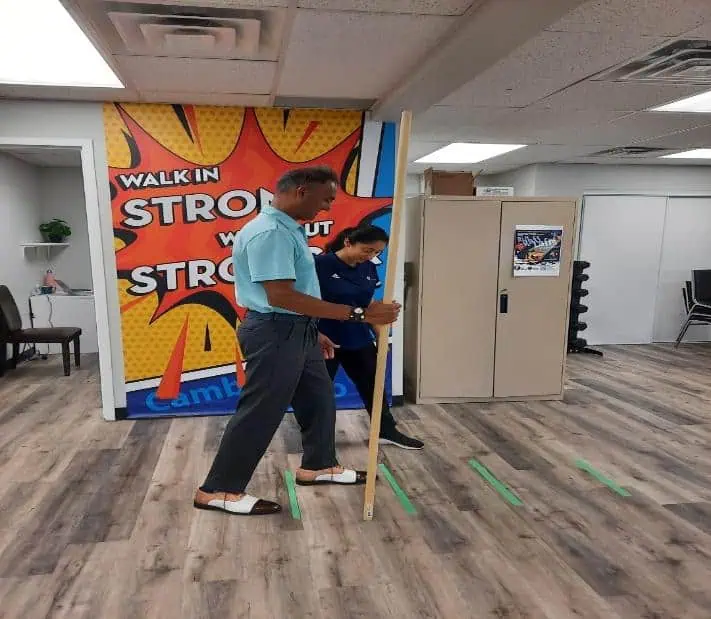
(Assisting Patients with Visual Cues in Cambridge Physiotherapy and Rehab Center)
Auditory Cueing Techniques
Auditory cues such as take big step, 1, 2, 3 stand, ready set go, big first step etc. have also been shown to improve gait. Cues should be consistent not rushed and have a rhythmical quality to them. Auditory cues appear to have a greater influence on temporal components of movement (e.g. gait cadence, stride synchronization).
Rhythmic auditory stimulation (RAS) includes the use of a metronome beat or steady beat from a musical listening device. The research shows it improves walking speed, cadence and step/stride length. The potential for different cueing devices including electronic devices is discussed in one of the studies, which can prove beneficial in the rehabilitation of Parkinson’s Disease3.
Benefits of Multisensory Cueing
Multisensory cueing (use of both auditory and visual cueing) has been used for patients with Parkinson’s. When sensory enhanced therapy using multisensory cueing was compared with conventional therapy, significant improvement was found in the sensory training group4.
Considerations and Limitations of Cueing
Cueing may not be effective in some cases like medication instability and disease fluctuations. However, in many patients, using external cues during treatment sessions is a valid strategy and one in which improvement in performance can be anticipated. Furthermore, directing attention to the motor action being practiced, giving feedback about its correctness and avoiding dual tasking are beneficial treatment strategies1. In fact, another study suggests that treadmill training associated with auditory and visual cues might give better results than more conventional treatments, in rehabilitation treatment of patients with freezing2.
The Role of Early Interventions
Early interventions play an important role to enhance walking abilities, reducing freezing episodes in Parkinson’s, fall prevention, improving balance and walking abilities, and helping you return to function. Contact our Physiotherapists for an assessment and a plan of care that best suits your goals.
References
- Olson M, Lockhart TE, Lieberman A. Motor Learning Deficits in Parkinson’s Disease (PD) and Their Effect on Training Response in Gait and Balance: A Narrative Review. Front Neurol. 2019 Feb 7;10:62. doi: 10.3389/fneur.2019.00062. PMID: 30792688; PMCID: PMC6374315.
- Frazzitta G, Maestri R, Uccellini D, Bertotti G, Abelli P. Rehabilitation treatment of gait in patients with Parkinson’s disease with freezing: a comparison between two physical therapy protocols using visual and auditory cues with or without treadmill training. Mov Disord. 2009 Jun 15;24(8):1139-43. doi: 10.1002/mds.22491. PMID: 19370729.
- Sweeney D, Quinlan LR, Browne P, Richardson M, Meskell P, ÓLaighin G. A Technological Review of Wearable Cueing Devices Addressing Freezing of Gait in Parkinson’s Disease. Sensors. 2019; 19(6):1277. https://doi.org/10.3390/s19061277
- Susan B. O’Sullivan, Thomas J. Schmitz. (2007). Physical rehabilitation. Philadelphia :F.A. Davis,


